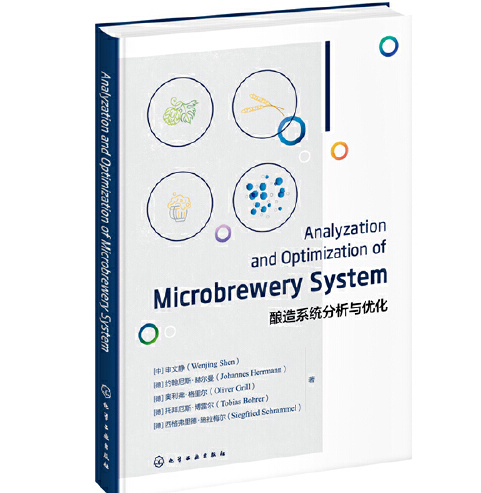《釀造系統分析與最佳化》是2020年化學工業出版社出版的圖書,作者是(中)申文靜,(德)約翰尼斯·赫爾曼,(德)奧利弗·格里爾,(德)托拜厄斯·博雷爾,(德)西格弗里德·施拉梅爾。該書內容包括啤酒釀造系統分析、LabVIEW與OPC協定、過程控制理論、釀造過程溫度控制。
基本介紹
- 中文名:釀造系統分析與最佳化
- 作者:(中)申文靜、(德)約翰尼斯·赫爾曼、(德)奧利弗·格里爾、(德)托拜厄斯·博雷爾、(德)西格弗里德·施拉梅爾
- 出版社:化學工業出版社
- ISBN:9787122371539
內容簡介,圖書目錄,作者簡介,
內容簡介
本書以德國啤酒釀造過程為背景,內容包括啤酒釀造系統分析、LabVIEW與OPC協定、過程控制理論、釀造過程溫度控制等內容,初步建立基於LabVIEW平台的啤酒釀造數位化工廠的模型,結合智慧型感測網路對整個生產過程進行仿真、評估、最佳化和智慧型控制。本書可供食品工程、機電、工業技術等行業的科學研究與技術開發人員參考,也可供相關專業大專院校師生閱讀。
圖書目錄
1 Introduction and objective 1
2 General explanation of a brewing process 4
2.1 Ingredients 4
2.1.1 Water 4
2.1.2 Malt 5
2.1.3 Hops 5
2.1.4 Yeast 6
2.2 Work steps for the production of beer 6
2.2.1 Grinding of the malt 7
2.2.2 Mashing 7
2.2.3 Lautering 7
2.2.4 Cooking and addition of hops 8
2.2.5 Hot break separation 8
2.2.6 Cooling of the wort 9
2.2.7 Pitching yeast 9
2.2.8 Fermentation 9
2.2.9 Secondary fermentation and storing 9
3 Description of the brewing plant 11
3.1 Controlling and monitoring of the plant 12
3.2 Four-tank system for the production of wort 13
3.2.1 Mash tank 14
3.2.2 Lauter tank 16
3.2.3 Boiling pot 17
3.2.4 Whirlpool 18
3.3 Fermentation and storage 20
3.3.1 Plate heat exchanger, yeast container and ice water tank 20
3.3.2 Fermentation and storage tanks 21
3.4 Additional components of the brewing plant 22
3.4.1 Cleaning of the fermentation tanks 22
3.4.2 Grinding of the malt 23
3.4.3 Storage of the malt and the hops 24
3.4.4 Production of steam 24
4 Collection of data from the mash tank 26
4.1 Geometrical dimensions 26
4.2 Materials and wall thicknesses 30
4.3 Stirring unit 30
4.4 Heat transfer from the steam to the brewing water 31
4.4.1 Experiments for the distinction of the energy supply by observation of the vapor pressure 32
4.4.2 Calculation of USB 33
4.5 Total heat transmission coeff?icient 35
4.5.1 Experiments for the measurement of the wall temperatures 37
4.5.2 Calculation of ho 39
4.5.3 Calculation of hi 42
4.5.4 Calculation of the total heat transmission coeff?icient 46
4.6 Volume flow of tap water 47
4.7 Summary of the values for the mash tank 48
5 Creation of a flow sheet of the brewing plant 49
5.1 Existing f?low sheet 50
5.2 Newly created f?low sheet 53
5.2.1 Malt milling 54
5.2.2 Steam production 54
5.2.3 Production of wort 58
5.2.4 Cooling of the wort and addition of yeast 59
5.2.5 Cooling water supply 60
5.2.6 Fermentation and storage 60
6 Description of the brewing process 62
6.1 Operation of the plant 62
6.2 Cleaning before the brewing process 65
6.3 Milling 68
6.4 Mashing 70
6.5 Lautering 73
6.6 Cooking 74
6.7 Hot break separation 76
6.8 Cooling 76
6.9 Pitching yeast 77
6.10 Fermentation 79
6.11 Secondary fermentation and storing the beer 80
6.12 Cleaning after the brewing process 81
7 Control of the brewing plant 84
7.1 Fundamentals of programmable logic controllers 84
7.2 S7-200 SMART 85
7.2.1 CPU S7-200 SMART SR40/ST60 85
7.2.2 EM AM06 86
7.2.3 EM AR04/AR02 86
7.3 Switch cabinet with basic functions 87
7.4 Switch cabinet for temperature control 89
8 Basics of network technology 92
8.1 Industrial Ethernet 92
8.2 OPC Foundation 94
8.3 OPC Technology 95
8.3.1 OPC Classic 95
8.3.2 OPC Unif?ied Architecture 97
9 Implementation of a LabVIEW program 99
9.1 Program interface 99
9.2 OPC Server software 100
9.2.1 Shared Variable Engine 100
9.2.2 DSC module 101
9.2.3 NI OPC Server 101
9.2.4 OPC tags 102
10 LabVIEW program—brewing plant control 106
10.1 Graphical user interface 106
10.2 Advanced Features 108
10.2.1 Dual control of the system via LabVIEW and control panel 109
10.2.2 Data Dashboard 111
11 Current temperature control system 113
11.1 Existing controller quality 113
11.2 Modif?ication of control valves and temperature sensor 115
12 Simulation of the mash tank’s temperature control 117
12.1 Controller design 117
12.1.1 Identif?ication of parameters 117
12.1.2 Basics of PID controlling 120
12.1.3 Fundamentals of Fuzzy control 123
12.1.4 PID controller design 128
12.1.5 Fuzzy controller design 130
12.2 Build-up of the simulation in LabVIEW 133
12.2.1 Representation of the controlled system 133
12.2.2 Program structure and functionality 134
12.2.3 Optimization of the simulated controllers 142
13 Implementation of the control system 146
13.1 Operation of the brewing plant 146
13.2 Experiments on the real system 147
13.2.1 Experiments with PI controller 148
13.2.2 Experiments with fuzzy controller 148
13.3 Comparison between simulation and reality 152
13.4 Further investigations 152
References 155
Appendix A 157
Appendix B 159
Figures 160
Tables 167
作者簡介
申文靜,深圳技術大學中德智慧型製造學院教師 ,香港城市大學博士畢業,曾獲香港政府全額獎學金,2018年獲深圳市海外高層次C類人才;研究方向為物理建模和參數最佳化,工業系統參數智慧型調節套用;主持並參與了多項國家省級自然科學基金和企業橫向課題,研究機電一體化系統集成和設備改造;發表國內外期刊論文十餘篇,申報國家發明專利八項,國際PCT專利兩項。與德國雷根斯堡套用技術大學合作,負責籌建“中德啤酒釀造過程控制實驗室”,主持教育部協同育人項目“啤酒釀造過程控制數位化工廠”,教研項目“中德過程控制聯合實驗室教學探索與研究”; 已在實驗室指導多名德國留學生進行釀造設備自動化改造。計畫初步建立基於LabVIEW平台的啤酒釀造數位化工廠的模型,結合智慧型感測網路對整個生產過程進行仿真、評估、最佳化和智慧型

